- Clone
- TM-β1 (See other available formats)
- Regulatory Status
- RUO
- Other Names
- IL-2 Receptor β chain, IL-2Rβ
- Isotype
- Rat IgG2b, κ
- Ave. Rating
- Submit a Review
- Product Citations
- publications
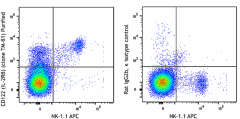
-

C57BL/6 mouse splenocytes stained with NK-1.1 APC and CD122 (IL-2Rβ) (clone TM-β1) Purified (left) or Purified Rat IgG2b, κ isotype control (right) followed by anti-rat IgG FITC.
CD122 is a 70-75 kD IL-2 receptor β chain also known as IL-2Rβ, which is also shared by the IL-15 receptor. It is constitutively expressed by NK cells and at lower levels by T cells, B cells, monocytes, and macrophages. The IL-2Rβ chain can combine with either the common γ subunit (γc, CD132) alone or with the γc subunit and the IL-2Rα subunit (CD25) to generate intermediate or high affinity IL-2 receptor complexes, respectively. CD122 expression levels can be upregulated by activation. The TM-β1 antibody does inhibit IL-2 binding to the IL-2 receptor. CD122 is expressed on murine, but not human, CD8+ Tregs involved in the maintenance of T cell homeostasis.
Product DetailsProduct Details
- Verified Reactivity
- Mouse
- Antibody Type
- Monoclonal
- Host Species
- Rat
- Immunogen
- Rat T cell line expressing mouse CD122 ( IL-2Rβ)
- Formulation
- 0.2 µm filtered in phosphate-buffered solution, pH 7.2, containing no preservative.
- Endotoxin Level
- Less than 0.01 EU/µg of the protein (< 0.001 ng/µg of the protein) as determined by the LAL test.
- Preparation
- The Ultra-LEAF™ (Low Endotoxin, Azide-Free) antibody was purified by affinity chromatography.
- Concentration
- The antibody is bottled at the concentration indicated on the vial, typically between 2 mg/mL and 3 mg/mL. Older lots may have also been bottled at 1 mg/mL. To obtain lot-specific concentration and expiration, please enter the lot number in our Certificate of Analysis online tool.
- Storage & Handling
- The antibody solution should be stored undiluted between 2°C and 8°C. This Ultra-LEAF™ solution contains no preservative; handle under aseptic conditions.
- Application
-
FC - Quality tested
IP, Block, Depletion - Reported in the literature, not verified in house - Recommended Usage
-
Each lot of this antibody is quality control tested by immunofluorescent staining with flow cytometric analysis. For flow cytometric staining, the suggested use of this reagent is ≤ 0.25 µg per 106 cells in 100 µl volume. It is recommended that the reagent be titrated for optimal performance for each application.
- Application Notes
-
Additional reported applications (for the relevant formats) include: immunoprecipitation1, blocking of IL-2 binding1, and NK cell depletion2 in vivo. The LEAF™ purified antibody (Endotoxin <0.1 EU/µg, Azide-Free, 0.2 µm filtered) is recommended for blocking of IL-2 binding in vivo and in vitro (Cat. No. 123204).
-
Application References
(PubMed link indicates BioLegend citation) -
- Tanaka T, et al. 1991. J. Immunol. 147:2222.
- Tanaka T, et al. 1993. J. Exp. Med. 178:1103.
- Tanaka T, et al. 1992. Int. Immunol. 4:487.
- Product Citations
-
- RRID
-
AB_2810376 (BioLegend Cat. No. 123227)
AB_2810375 (BioLegend Cat. No. 123226)
AB_2810377 (BioLegend Cat. No. 123228)
AB_2810372 (BioLegend Cat. No. 123223)
AB_2810373 (BioLegend Cat. No. 123224)
AB_2810374 (BioLegend Cat. No. 123225)
Antigen Details
- Structure
- Ig superfamily, forms high affinity IL-2 receptor with CD25 and CD132 chains or intermediate affinity receptor with CD132 alone, 70-75 kD
- Distribution
- T and B cells, NK cells, monocytes, macrophages
- Function
- Critical component of IL-2 and IL-15 signaling
- Ligand/Receptor
- IL-2, IL-15
- Cell Type
- B cells, Macrophages, Monocytes, NK cells, T cells, Tregs
- Biology Area
- Immunology
- Molecular Family
- CD Molecules, Cytokine/Chemokine Receptors
- Antigen References
-
1. Barclay A, et al. 1997. The Leukocyte Antigen FactsBook Academic Press.
2. Minami Y, et al. 1993. Annu. Rev. Immunol. 11:245.
3. Suzuki H, et al. 1995. Science 268:1472.
4. Shi Z, et al. 2009. Eur. J. Immunol. 39:2109. - Gene ID
- 16185 View all products for this Gene ID
- UniProt
- View information about CD122 on UniProt.org
Related FAQs
- Do you guarantee that your antibodies are totally pathogen free?
-
BioLegend does not test for pathogens in-house aside from the GoInVivo™ product line. However, upon request, this can be tested on a custom basis with an outside, independent laboratory.
- Does BioLegend test each Ultra-LEAF™ antibody by functional assay?
-
No, BioLegend does not test Ultra-LEAF™ antibodies by functional assays unless otherwise indicated. Due to the possible complexities and variations of uses of biofunctional antibodies in different assays and because of the large product portfolio, BioLegend does not currently perform functional assays as a routine QC for the antibodies. However, we do provide references in which the antibodies were used for functional assays and we do perform QC to verify the specificity and quality of the antibody based on our strict specification criteria.
- Does BioLegend test each Ultra-LEAF™ antibody for potential pathogens?
-
No, BioLegend does not test for pathogens in-house unless otherwise indicated. However, we can recommend an outside vendor to perform this testing as needed.
- Have you tested this Ultra-LEAF™ antibody for in vivo or in vitro applications?
-
We don't test our antibodies for in vivo or in vitro applications unless otherwise indicated. Depending on the product, the TDS may describe literature supporting usage of a particular product for bioassay. It may be best to further consult the literature to find clone specific information.
Other Formats
View All CD122 Reagents Request Custom Conjugation| Description | Clone | Applications |
|---|---|---|
| Biotin anti-mouse CD122 (IL-2Rβ) | TM-β1 | FC |
| FITC anti-mouse CD122 (IL-2Rβ) | TM-β1 | FC |
| PE anti-mouse CD122 (IL-2Rβ) | TM-β1 | FC |
| PerCP/Cyanine5.5 anti-mouse CD122 (IL-2Rβ) | TM-β1 | FC |
| APC anti-mouse CD122 (IL-2Rβ) | TM-β1 | FC |
| PE/Cyanine7 anti-mouse CD122 (IL-2Rβ) | TM-β1 | FC |
| PE/Dazzle™ 594 anti-mouse CD122 (IL-2Rβ) | TM-β1 | FC |
| PE/Cyanine5 anti-mouse CD122 (IL-2Rβ) | TM-β1 | FC |
| APC/Cyanine7 anti-mouse CD122 (IL-2Rβ) | TM-β1 | FC |
| Ultra-LEAF™ Purified anti-mouse CD122 (IL-2Rβ) | TM-β1 | FC,IP,Block,Depletion |
| Brilliant Violet 421™ anti-mouse CD122 (IL-2Rβ) | TM-β1 | FC |
Customers Also Purchased
Compare Data Across All Formats
This data display is provided for general comparisons between formats.
Your actual data may vary due to variations in samples, target cells, instruments and their settings, staining conditions, and other factors.
If you need assistance with selecting the best format contact our expert technical support team.
-
Biotin anti-mouse CD122 (IL-2Rβ)
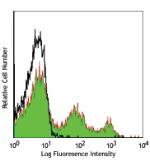
C57BL/6 mouse splenocytes stained with biotinylated TM-β1, f... -
FITC anti-mouse CD122 (IL-2Rβ)

C57BL/6 mouse splenocytes stained with TM-β1 FITC -
PE anti-mouse CD122 (IL-2Rβ)
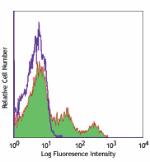
C57BL/6 mouse splenocytes stained with TM-β1 PE -
PerCP/Cyanine5.5 anti-mouse CD122 (IL-2Rβ)
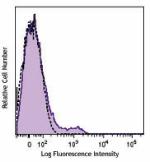
C57BL/6 mouse splenocytes were stained with CD122 (clone TM-... -
APC anti-mouse CD122 (IL-2Rβ)
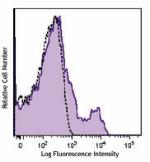
C57BL/6 mouse splenocytes were stained with CD122 (clone TM-... -
PE/Cyanine7 anti-mouse CD122 (IL-2Rβ)
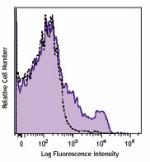
C57BL/6 mouse splenocytes were stained with CD122 (clone TM-... -
PE/Dazzle™ 594 anti-mouse CD122 (IL-2Rβ)
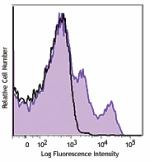
C57BL/6 mouse splenocytes were stained with CD122 (clone TM-... -
PE/Cyanine5 anti-mouse CD122 (IL-2Rβ)

C57BL/6 mouse splenocytes were stained with CD122 (clone TM-... -
APC/Cyanine7 anti-mouse CD122 (IL-2Rβ)

C57BL/6 mouse splenocytes were stained with NK-1.1 FITC and ... -
Ultra-LEAF™ Purified anti-mouse CD122 (IL-2Rβ)

C57BL/6 mouse splenocytes stained with NK-1.1 APC and CD122 ... -
Brilliant Violet 421™ anti-mouse CD122 (IL-2Rβ)

C57BL/6 mouse splenocytes were stained with anti-mouse NK-1....
 Login / Register
Login / Register 






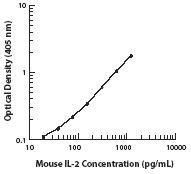
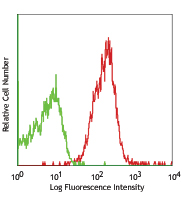
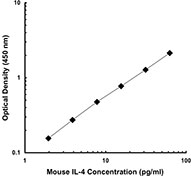




Follow Us